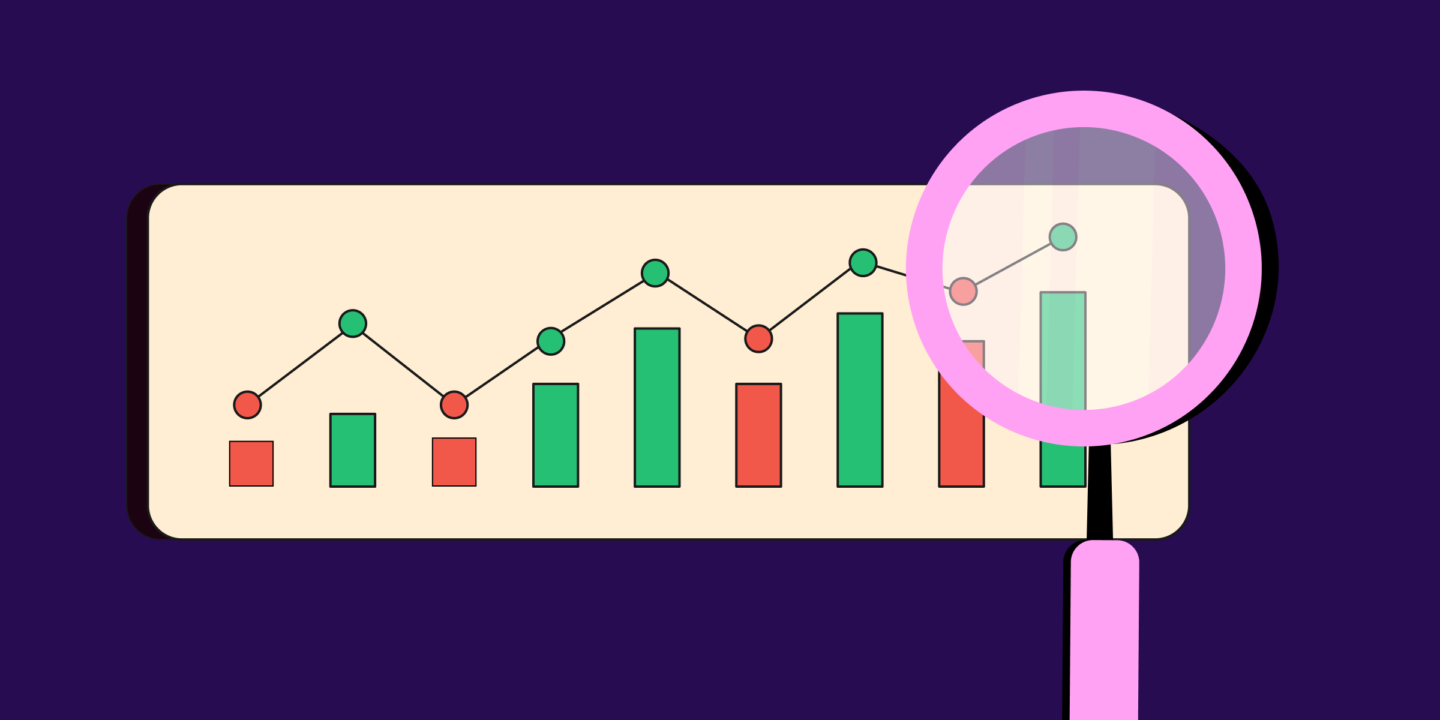
There are two types of people in this world. Ones who whine over the volatility of the crypto market, and others, who leverage it. Yes, you read that right. Like any emerging asset class, cryptocurrencies have wilder swings than traditional assets, but how can you use them for your benefit? The answer lies in the age-old art of trading. And for trading, one needs to learn crypto technical analysis.
The charts, the trends, the indicators, and the signals. All of this combined transforms into an epic superpower. A superpower that enables you to make smart decisions about the future of a cryptocurrency. Of course, no one can get it right to the T. But then, it teaches you an immensely valuable lesson about calculated risks and rewards. So today, we are going to talk about some tips and tricks of crypto technical analysis and dive deeper into it. Hold on to your seats because we’re going to the moon.
Technical Analysis: An Overview
Technical analysis comes from the statistical domain of mathematics. It aims at reading charts and evaluating the past price movement with the volumes to predict the possible future direction of the price.
A typical technical analyst would go through the years of history of an asset to check out specific patterns that affect the price. Based on that, he/she will create a system and use that system to buy or sell crypto at specific points to gain profits.
Technical analysis is based on three key assumptions.
1. News is already factored into price
It is a fair assumption that whatever could have affected the price has already done it. For example, if you read in the news that Polygon is going carbon neutral, the price of MATIC (the native token of Polygon) has already accounted for it.
This solves a dual purpose. The first is that you position yourself in a way that no insider information will reach you before anyone else. This is true in most cases.
Secondly, it also makes sure that you work on the technical indicators and charts and do not focus on fundamental shifts to change your strategy in the middle of the trade.
2. The trend is your friend
The second assumption is that nothing happens in the crypto market without a reason. There is always a price action that consistently follows specific trends.
What may seem like a random stroke of luck to a normie, a trader could validate it as a trend and use it in the future to gain profits.
3. History repeats
The fact that humans do not learn from their mistakes is a corollary of this aspect. This history always repeats in the crypto markets. Therefore, when studied by overlaying the context of current situations, one can guess the future of assets.
How Does Technical Analysis Help With Crypto?
Technical analysis is a powerful method of predicting the price movement of any asset class. It does make a lot more sense in the crypto realm.
This is because a lot of participants in the crypto market are still figuring out the fundamentals of the space. This means, more and more decisions are emotion-driven and impulsive rather than evaluated based on fundamentals.
As a result, a trader has a higher probability of getting their guesses right.
Other than that, technical analysis also helps investors pick the correct entry and exit points for their investments. This could be a game changer, even if you are in it for the long term.
Crypto Technical Analysis Tools and Indicators
Now that we have brushed up our knowledge of crypto technical analysis, it is time to dive deeper into the tools and indicators. Let’s get started.
1. Candlestick charts
Almost all the crypto and stock-related charts which indicate price and volume are represented in the form of candlestick charts. This is because candlestick charts can pack in a lot more information without creating clutter.
Each candle in the chart has two parts: The body and the wick.
The body represents the opening and closing price of the crypto during the specific period. Usually, color is added to the body to represent the price movement. If it is red, the closing price < opening price. If it is green, it represents that the closing price is greater than the opening price.
The wick represents the all-time high and low during that duration. The upper wick would represent the highest price hit, and the lower wick represents the lower value.
2. Support and resistance
Support is defined as the area of heightened buying interest. This means if the price is observing a downward trend, it is unlikely to fall below a support level. This makes the support level a good entry point as the crypto may go upwards from there on.
Similarly, resistance is an area of increased selling interest. If the price is rising, it is unlikely to breach a resistance mark. This is where traders usually book profits or short the crypto because the price may go down from here.
These levels can be identified by analyzing the charts for the areas where the price has repeatedly bounced and changed direction.
3. Trend lines
The trend line is a single straight line that connects multiple price points on the chart. These price points can be lows or highs of price movement. The more points it touches, the stronger the trend. Trend lines are used to draw and hypothesize the potential emergence of a trend in the market.
A trader could also draw multiple trend lines to come up with more complex patterns that reveal some insights about the future.
4. Moving average
The moving average is one of the most common indicators used by technical analysts. It is often calculated for a period of 10, 20, 50, 100, or 200 days. As the name suggests, the moving average indicates the average price of the cryptocurrency for the selected period. This usually helps in getting rid of the noise exhibited by sudden spikes and dips in the price.
The moving average can be divided into subcategories based on the way it is calculated.
A simple moving average is the average of prices over a period. A weighted moving average assigns higher weights to specific periods (recent prices, mostly). And the exponential moving average gives weights that vary for a period.
5. Relative index strength (RSI)
RSI, or relative index strength, is an oscillatory indicator. It is range-bound between 0-100. The entire aim of evaluating RSI is to figure out if an asset is overbought or oversold.
Typically, a crypto is oversold if RSI<30 and overbought if RSI>70.
No surprises for guessing that RSI<30 could hint at a good entry price in contrast to RSI >70
6. Bollinger band
Bollinger bands further validate the overbought/oversold state of crypto.
These are calculated by taking a 20-day moving average and adding or subtracting a standard deviation from it.
If the market price is above the Bollinger band, it indicates overbought and vice-versa.
7. Average directional index (ADX)
Another oscillator indicator in the store. Similar to RSI, ADX can move between 0 to 100. ADX is a short-term indicator that helps traders evaluate the strength of a trend. The higher the ADX, the more momentum for the current trend.
Analysts believe that an ADX value > 25 indicates a strong trend, and <20 indicates no trend at all.
Any value between 20 and 25 shows a neutral trend.
How Is Crypto Technical Analysis Different From Fundamental Analysis?
Technical analysis alone will not sail your boat. One has to look at all the indicators in context to fundamentals as they present only half the picture. While both of these analyses formulate a strong conviction-based decision, here are the key differences between the two.
- Technical analysis relies on charts, indicators, and signals to derive the intrinsic value of a cryptocurrency. Whereas fundamental analysis focuses a lot more on factors like the team, usage of the cryptocurrency, on-chain metrics, and future potential of the project.
- Technical analysis is meant for short-term trading where the price action is effective for the current trend alone. Once the trend changes, a trader will take new positions. On the other hand, fundamental analysis is meant for the long term, which is often called as buy and hold strategy.
- From a data standpoint, technical analysis is purely focused on the past data of the project. ‘History repeats itself’ is one of the core philosophies of technical analysis. On the flip side, fundamental analysis looks at the past, present, and future of the project.
What Are the Limitations of Technical Analysis?
While technical analysis has been used by millions of traders worldwide to earn a living for themselves, it does have some limitations attached to it. For example, technical analysis is often inconsistent. The market can behave irrationally more than you can stay solvent. This is why one has to take their analysis with a pinch of salt.
Moreover, technical analysis is incomplete without a fundamental understanding of cryptocurrency. If you try to rely on technical analysis alone, you might end up losing your money.
To top it all, legendary investors believe that wealth is generated in the long term. So while you are trading regularly, you should anyway have your investing portfolio separated that is meant for the long-term.
Another limitation of technical analysis is that it requires a lot of time to learn, practice and master. And even after that, you need to pay constant attention to the prices to see if your strategy is working out or not. In other words, you cannot be a part-time trader.
Conclusion
To sum it up, technical analysis is a wonderful trait for any prudent investor. Not only can it save you from buying or selling at the wrong points (which, in turn, deter your conviction), but it also leads to meaningful profits by virtue of correct entry and exit.
But it is completely okay if you feel that technical analysis is not your cup of tea. All of us do not have the liberty of time to analyze cryptos this closely.
This is why there’s a way you can outsource your research to a team of experts. All you got to do is to have a broader understanding of a theme and pick the best-performing cryptos in that theme. This theme could be anything from blue chips, metaverse, NFTs, etc.
In fact, I have just the tool for that. Head over to Coin Sets by Mudrex to explore the world of thematic investing.
FAQs
1. Which cryptocurrency chart is best for analysis?
While technical analysis can be applied to all assets alike, not only cryptocurrencies, one of the key assumptions is that history will repeat itself. Since cryptocurrency is a new asset class, we only have roughly a decade of history attached to it. So if you are new to crypto trading, it is better that you start with the oldest crypto like BTC and ETH.
2. Is technical analysis the same for crypto as other assets?
Mostly yes! Technical analysis for crypto has a lot of similarities with stocks and other assets. However, the fundamentals involved are completely different, which makes your approach to crypto trading different. For example, there’s a concept of burning crypto tokens or removing them from circulation. This is the equivalent of stock buybacks. One needs to keep an eye on such nuances while trading.





